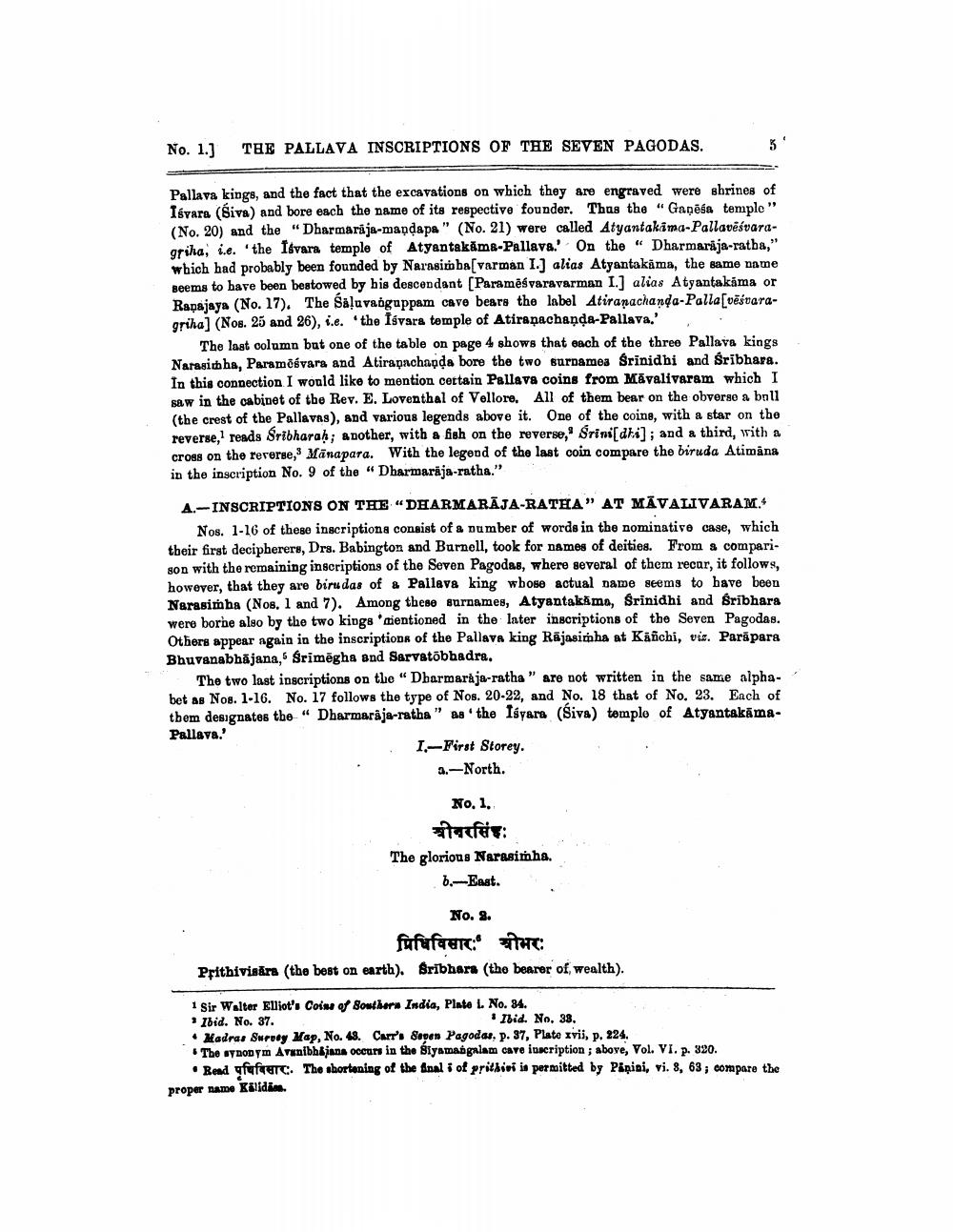________________
No. 1.]
THE PALLAVA INSCRIPTIONS OF THE SEVEN PAGODAS.
Pallava kings, and the fact that the excavations on which they are engraved were shrines of Isvara (Biva) and bore each the name of its respective founder. Thus the “Gadēša temple" (No. 20) and the “Dharmaraja-mapdapa" (No. 21) were called Atyantakama-Pallavēsvaragriha, i.e. 'the fsvara temple of Atyantakāma-Pallava.' On the “ Dharmaraja-ratba," which had probably been founded by Narasimba(varman 1.) alias Atyantakima, the same name Beems to have been bestowed by his descendant (Paramėśvaravarman I.] alias Atyantakāma or Rapajaya (No. 17). The Saluvaiguppam cave bears the label Atiranachanda-Palla[vēšvaragriha) (Nos. 25 and 26), i.e. the fśvara temple of Atiranachanda-Pallava.'
The last column but one of the table on page 4 shows that each of the three Pallava kings Narasith ha, Paramośvara and Atirapachnoda bore the two surnames Srinidhi and Sribhara. In this connection I would like to mention certain Pallava coins from MĀvalivaram which I saw in the cabinet of the Rev. E. Loventhal of Vellore. All of them bear on the obverse a bull (the crest of the Pallavas), and various legends above it. One of the coine, with a star on the reverse, reads Sribharah; another, with a fish on the reverse, Srini[dh]; and a third, with a cross on the rererse, Mānapara. With the legend of the last coin compare the biruda Atimana in the inscription No. 9 of the “Dharmaraja-ratha."
A.-INSCRIPTIONS ON THE DHARMARĀJA-RATHA” AT MÄVALIVARAM.
Nos. 1-16 of these inscriptions consist of a number of words in the nominative case, which their first decipherers, Drs. Babington and Burnell, took for names of deities. From a comparison with the remaining inscriptions of the Seven Pagodas, where several of them recar, it follows, however, that they are biru das of & Pallava king wbose actual name seems to have been Narasimha (Nos. 1 and 7). Among these surnames, Atyantakšma, Srinidhi and Sribhara were borbe also by the two kings 'nientioned in the later inscriptions of the Seven Pagodas. Others appear again in the inscriptions of the Pallava king Räjasimha at Käfichi, vis. Paräpara Bhuvanabhājana, Srimēgha and Sarvatöbhadra.
The two last inscriptions on the Dharmaraja-ratha " are not written in the same alphabet as Nos. 1-16. No. 17 follows the type of Nos. 20-22, and No. 18 that of No. 23. Each of thom designates the " Dharmaraja-ratha" as the Isyara (Siva) templo of AtyantakāmaPallava.'
1.-First Storey.
4.-North.
No. 1.
श्रीनरसिंहः The glorious Narasimha.
6.-East.
No. .
प्रिधिविसार: श्रीभरः Prithivisārs (the best on earth). Bribhars (the bearer of wealth).
1 Sir Walter Elliot's Coins of Southern India, Plate L No. 84. Ibid. No. 37.
* Ibid. No. 33. • Madras Surody Map, No. 48. Carr's Sepen Pagodat, p. 37, Plate xvii, p. 224.
The synonym Arunibhijana occur in the Siyamangalam cave inscription ; above, Vol. VI. p. 320.
• Bend gfufaerc. The shortening of the Anal i of prithivi in permitted by Pipini, vi. 8, 63; compare the proper name Kilidi..




